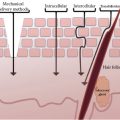Prevalence of Sensitive Skin According to Sex
|
Men (%) |
Women (%) |
Global (%) |
P Value χ2 |
|
|
Very sensitive |
12.53 |
28.43 |
20.7 |
|
|
Rather sensitive |
33.82 |
42.55 |
38.2 |
|
|
Slightly sensitive |
32.99 |
22.63 |
27.5 |
|
|
Not sensitive |
20.67 |
6.38 |
13.2 |
<.001 |
TABLE 16.2
Score of the Two Dimensions of the SF-12
|
Men |
Women |
Global |
P Value χ2 |
|
|
PCS-12 |
50.2 ± 7.9 |
49.7 ± 8.6 |
49.9 ± 8.3 |
0.2806 |
|
MCS-12 |
47.9 ± 9.1 |
45.7 ± 9.8 |
46.8 ± 9.5 |
0.0005 |
There was no significant difference in mental and physical scores according to skin sensitivity. However, the mental scores were statistically different according to skin sensitivity, with some differences between men and women:
• Males: 45.6 for the sensitive skin group versus 49.7 for the not sensitive group (P < .0001)
• Females: 44.6 for the sensitive skin group versus 47.3 for the not sensitive group (P = .0024)
The fact that the MCS is altered, while the PCS is not, is not surprising! This result is usually found in all publications that evaluated the SF-12 in various dermatoses (3–7) because SF-12 is the general scale for the measurement of quality of life and not a specific scale for patients with disorders.
Comparisons of the mental scores according to the levels of perceived intensity of sensitive skin (very sensitive, rather sensitive, slightly sensitive, not sensitive) show that the MCS of quality of life is more altered when the intensity of the declared skin sensitivity is more severe (Tables 16.3 and 16.4).
TABLE 16.3
Score of the Two Dimensions of the SF-12 as Expressed Sensitivity
|
PCS-12 Men |
PCS-12 Women |
MCS-12 Men |
MCS-12 Women |
|
|
Sensitive |
49.8 ± 8.4 |
49.5 ± 8.2 |
45.6 ± 9.9 |
44.6 ± 10.3 |
|
Not sensitive |
50.6 ± 7.7 |
49.8 ± 9.1 |
49.7 ± 7.8 |
47.3 ± 8.7 |
TABLE 16.4
Score of the Two Dimensions of the SF-12 According to the Severity of Skin Sensitivity
|
PCS-12 Male |
PCS-12 Women |
MCS-12 Male |
MCS-12 Women |
|
|
Very sensitive |
48.0 ± 9.9 |
49.3 ± 8.9 |
43.6 ± 11.7 |
42.2 ± 11.9 |
|
Rather sensitive |
50.9 ± 7.9 |
49.6 ± 7.9 |
46.1 ± 9.4 |
45.5 ± 9.6 |
|
Slightly sensitive |
50.9 ± 7.1 |
50.4 ± 8.4 |
48.4 ± 7.9 |
46.9 ± 8.9 |
|
Not sensitive |
50.2 ± 7.7 |
48.7 ± 10.1 |
51.3 ± 7.4 |
47.8 ± 84 |
Evaluation of depressive symptomatology using the HAD scale showed that there was no significant link between depressive symptomatology and skin sensitivity; in the group that answered, “sensitive skin,” 4.3% of the subjects presented a certain depressive symptomatology against 4.8% in the group that answered, “not sensitive skin.”
In conclusion, the MCS of quality of life, measured by the SF-12 scale, is altered in people who suffer from sensitive skin, and the higher the sensitivity, the more affected is the quality of life. These results are similar to those that are observed in skin diseases.
REFERENCES
1. Science Direct, http://www.sciencedirect.com/, 2015, May.
2. Misery L, Myon E, Martin N et al. Sensitive skin: Psychological effects and seasonal changes. J Eur Acad Dermatol Venereol. 2007; 21: 620–628.
3. Sibaud V, Dalenc F, Chevreau C et al. HFS-14, a specific quality of life scale developed for patients suffering from hand-foot syndrome. Oncologist 2011; 16: 1469–1478.
4. Boccara O, Méni C, Léauté-Labreze C et al. Haemangioma family burden: Creation of a specific questionnaire. Acta Derm Venereol. 2015; 95: 78–82.
5. Dufresne H, Hadj-Rabia S, Méni C, Sibaud V, Bodemer C, Taïeb C. Family burden in inherited ichthyosis: Creation of a specific questionnaire. Orphanet J Rare Dis. 2013; 8: 28.
6. Méni C, Bodemer C, Toulon A et al. Atopic dermatitis burden scale: Creation of a specific burden questionnaire for families. J Eur Acad Dermatol Venereol. 2013; 27: 1426–1432.
7. Taïeb A, Boralevi F, Seneschal J, Merhand S, Georgescu V, Taïeb C, Ezzedine K. The atopic dermatitis burden scale for adults: Development and validation of a new assessment tool (ABS-A). Acta Derm Venereol. 2015; 5: 700–705.




